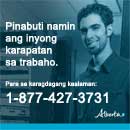- News Front Page
- Uncategorized
- Headline News
- Filipino Calgarian
- Business
- Pinoy Stories
- Community News
- Publisher's Note
- The Main Ingredient
- Views and Opinions
- Maikling Kwento
- Alberta News
- OFW – Month
- Travel News
- Health and Lifestyle
- Pinoy Toons
- Pinoy Spirit
- Entertainment
- The Philippine Lawyer
- Horoscope
- Greetings
- About Us
- Greetings From the Prime Minister
- Greetings from the President of the Philippines
- Greetings from the Premier of Alberta
- Greetings from the Mayor of Calgary
- Advertise With Us
- Disclaimer
- Subscription
Publisher's Note
- Publisher’s Note
 It was 22 years ago when I arrived in Canada and chose Calgary, Alberta to be my home. Leaving my family and friends behind, it was a new adventure for me to be in a new country without knowing anyone. That was the time I looked for a Filipino community paper and never found any, [...]
It was 22 years ago when I arrived in Canada and chose Calgary, Alberta to be my home. Leaving my family and friends behind, it was a new adventure for me to be in a new country without knowing anyone. That was the time I looked for a Filipino community paper and never found any, [...]
Visitors to Pinoytimes
Page added on March 17, 2015
Living with Asthma
You can limit the impact asthma has on your child’s life by learning about asthma and learning how you can help your child follow his or her asthma action plan.
Learn about asthma and see your doctor
- Educate yourself and your child about asthma. Asthma education programs provided by certified asthma educators (CAEs) are available in most areas. Ask your doctor or contact the Asthma Society of Canada, the Canadian Lung Association, or the Canadian Network for Asthma Care to learn about asthma education programs.
- See your child’s doctor regularly to monitor asthma. The frequency of checkups depends on how your child’s asthma is classified. Bring the asthma plan to each appointment.
- Set goals that relate to your child’s quality of life. Decide together what you want to be able to do. Have symptom-free nights? Be able to play soccer? Feel secure in knowing you both can deal with an asthma attack? Work with your doctor to make sure your child’s goals are realistic and your child knows how to reach them.
Follow your child’s action plan
- The asthma action plan helps you minimize the long-term effects of asthma and describes which medicines to take every day. The action plan also contains the steps to handle asthma attacks at home.
- Your child also may have an asthma diary, for writing down the symptoms and triggers of an asthma attack. Your doctor may also ask you to keep track of your child’s peak expiratory flows (PEF). Knowing your child’s PEFs can help your doctor manage your child’s asthma. This valuable tool can help your doctor manage your child’s asthma.
- Understand your child’s barriers and solutions. What may prevent your child from following his or her plan? These may be physical barriers, such as living far from your doctor or pharmacy. Or your child may have emotional barriers, such as having undiscussed fears about the condition or unrealistic expectations. Talk with the doctor about your child’s barriers, and work to find solutions.
Monitor peak expiratory flow
It is easy to underestimate the severity of asthma. Measuring peak expiratory flow (PEF) is a way to keep track of asthma symptoms at home and to know when your child’s lung function is getting worse before it drops to a dangerously low level.
Know your child’s asthma triggers
A trigger is anything that can lead to an asthma attack. If your child can avoid triggers, he or she may reduce the chance of having an asthma attack.
Control allergens
Your child may be allergic to certain substances (allergens). You may reduce your child’s asthma symptoms by limiting exposure to those substances.
- Control dust mites. House dust mites have been linked with asthma in children.
- Control animal dander and pet allergens. If your pet is a known trigger for your child, you may need to think about giving your pet away. If that is too hard, taking steps such as keeping your pet out of your child’s bedroom and dusting and vacuuming often may help your child’s asthma.
- Control indoor mould, especially if you live in an area with high humidity.
- Control Cockroaches, especially if you or your child live in an area where cockroaches are common.
It also may be necessary to avoid exposure to other types of triggers that cause asthma symptoms.
- Have your child avoid foods that may cause asthma symptoms. Some children have symptoms after eating processed potatoes, shrimp, or dried fruit. These foods and liquids contain sulphites, which may cause asthma symptoms.
- If pain relief medicines such as ibuprofen seem to cause asthma symptoms or make them worse, use acetaminophen (such as Tylenol) for pain relief. (Do not give aspirin to anyone younger than 20 because of the risk of Reye syndrome.)
Control symptoms at night
Coughing and wheezing can wake your child. Special problems that might cause night symptoms include:
- Delayed allergic reactions. Sometimes allergens that get in the airway can cause problems up to 8 hours later. Talk to your doctor about treating allergies that affect your child at night. The doctor may be able to change your child’s medicine or the time your child takes it.
- Medicine that wears off in early morning, causing your child to wake up. To make sure that the medicine lasts through the night, the doctor may be able to change your child’s dosage or medicine or the time your child takes the medicine.
Treating a sinus infection, cold, or allergies can keep your child’s symptoms from occurring at night.
Avoid upper respiratory infections
Upper respiratory infections, including the common cold, cause 85 out of 100 asthma attacks in young children. Basic preventive measures include the following:
- Avoid contact with other people who are ill. If there is an ill child in the home, separate him or her from other children, if possible.
- If you have a respiratory infection, such as a cold or the flu, or if you are caring for someone with a respiratory infection, wash your hands before and after caring for this person.
- Do not smoke. Second-hand smoke irritates the mucous membranes in your child’s nose, sinuses, and lungs and increases his or her risk for respiratory infections.
- Children who have asthma and their family members should get an influenza vaccine (flu shot or nasal spray vaccine) every year.
To learn more, contact your doctor or speak to a nurse 24 hours a day, seven days a week by calling: HealthLink Alberta toll free at 1-866-408-LINK (5465). Mandarin Health Link Calgary at 403-943-1554, Cantonese Health Link Calgary at 403-943-1556
Source: www. myhealth.alberta.ca
RELATED STORIES
LATEST HEADLINES
- ISKWELAHANG PILIPINO (IP) RONDALLA OF BOSTON WINS THE HEARTS OF CALGARIANS
- Pinay doctor joins Medicus Family Clinic and Pharmacy
- Multicultural Ethnic Media round table with Minister of Finance Joe Ceci together with Minister of Social Services Irfan Sabir
- Trans Mountain Pipeline keeps Canada working
- Facilitating travel to Canada while keeping Canadians safe
COMMUNITY NEWS
 A new way forward for some immigration application processing times
A new way forward for some immigration application processing times Calgary Stampede 2018 Poster
Calgary Stampede 2018 Poster Alberta celebrates first Philippine Heritage Month
Alberta celebrates first Philippine Heritage Month UPAAA Welcomes New Philippine Consul General
UPAAA Welcomes New Philippine Consul GeneralPINOY STORIES
 Duterte signs National ID System Act
Duterte signs National ID System Act- Holy Week practices in the Philippines
PINOY SPIRIT
HAVE YOUR SAY
Lorem ipsum dolor sit amet, consectetur adipiscing elit, dolor sit ipsum.PROMOTIONAL BLOCK
Lorem ipsum dolor sit amet, consectetur adipiscing elit, dolor sit ipsum.TRAVEL NEWS
PINOY TOONS
Tags
Archives

















